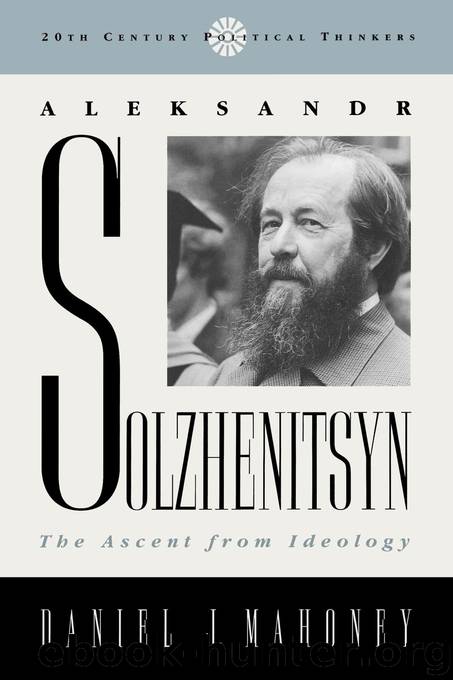Aleksandr Solzhenitsyn by Daniel J. Mahoney

Author:Daniel J. Mahoney
Language: eng
Format: epub
Publisher: Rowman & Littlefield Publishers
Published: 2001-03-22T05:00:00+00:00
STOLYPIN’S VISIONARY PROGRAM
After his confrontation with the State Council and Duma over the western zemstvo bill, Stolypin set out to confront the enemy from within, the intransigent bureaucracy that had been suspicious of his every move. “The healing of the legs, the lower limbs, the peasantry, was proceeding splendidly; the time had now come to heal the bureaucracy” (598). In May 1911, he dictated a visionary program of reform to his secretary, a program confiscated by the government after his death. His program was arranged systematically and laid out changes for each of the branches of the state administration. A new ministry would give support to the zemstvos in carrying out administrative, welfare, and educational tasks. A new ministry of labor would “draft laws to improve (the position) of Russian workers, and to make the rootless proletarian a partner in the constructive work of the state and the zemstvos” (598–99). Stolypin outlined plans for greater financial backing for the education of clergy and expressed support for the restoration of the Patriarchate—and hence the establishment of a genuinely independent Orthodox Church (599). Special emphasis was placed on education, including the goal of universal free primary education by the year 1922 and a huge expansion in the number of state-supported intermediate educational institutions and high schools. At the summit of the educational system, Stolypin wished to establish a national academy to train civil servants. “A dazzling array of specialists and experts would take their place in the Russian government machine” (600). The Tsar would then be able to draw on competent professionals in government and would not be dependent on the advice of courtiers for the choice of ministers. Stolypin insisted that the precondition of his reform program was peace abroad and a rejection of grandiose projects of Russian territorial expansion (600). Russian national greatness depended on a reform of the state apparatus and active efforts to improve the lives of ordinary people. Maintenance of a European peace, and the cultivation of good relations with the United States were also important pillars of his program (600).
Stolypin’s reform agenda aimed at nothing less than the comprehensive reconstruction of Russia by 1927–32. Of course, Solzhenitsyn’s readers know that a very different plan was imposed on “Soviet” society during those years—a plan that relied upon class struggle, collectivization, and forced industrialization and that utilized terror as its instrument. Solzhenitsyn leaves no doubt which was the genuinely humane and “progressive” plan for Russia’s reconstruction. Solzhenitsyn sadly notes that Stolypin’s project “vanished, was never published, discussed, exhibited, or indeed recovered—all that survived was the testimony of the man who helped Stolypin to draft it” (601). Tragically, the communists’ first Five-Year plan “coincided with what would have been the last five-year period of Stolypin’s project” (601).
Download
This site does not store any files on its server. We only index and link to content provided by other sites. Please contact the content providers to delete copyright contents if any and email us, we'll remove relevant links or contents immediately.
The Rules Do Not Apply by Ariel Levy(4863)
Bluets by Maggie Nelson(4476)
Too Much and Not the Mood by Durga Chew-Bose(4276)
Pre-Suasion: A Revolutionary Way to Influence and Persuade by Robert Cialdini(4151)
The Motorcycle Diaries by Ernesto Che Guevara(4016)
Walking by Henry David Thoreau(3895)
Schaum's Quick Guide to Writing Great Short Stories by Margaret Lucke(3322)
What If This Were Enough? by Heather Havrilesky(3275)
The Daily Stoic by Holiday Ryan & Hanselman Stephen(3235)
The Day I Stopped Drinking Milk by Sudha Murty(3159)
The Social Psychology of Inequality by Unknown(2941)
Why I Write by George Orwell(2877)
Letters From a Stoic by Seneca(2738)
A Short History of Nearly Everything by Bryson Bill(2630)
A Burst of Light by Audre Lorde(2548)
Insomniac City by Bill Hayes(2500)
Feel Free by Zadie Smith(2436)
Upstream by Mary Oliver(2344)
Miami by Joan Didion(2324)
